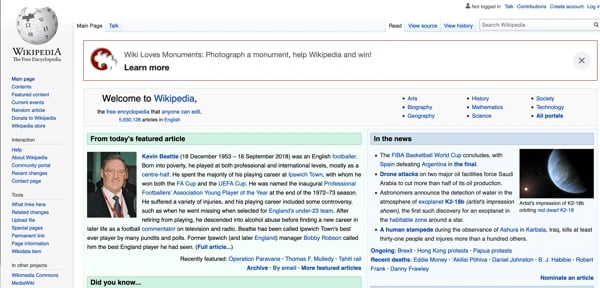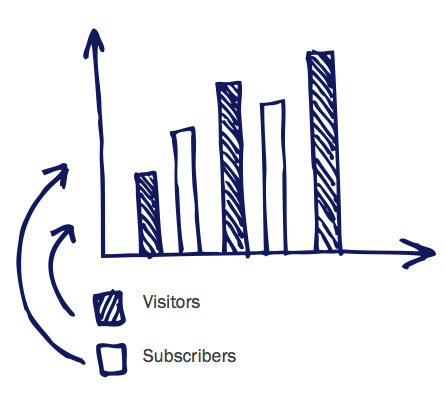What is evergreen content?
Evergreen content discusses topics that will stay relevant amd valuable for a longer period of time with only minor updates related to data or dates.
We have some good examples of evergreen content below, but the gold standard are those companies who build pages that we all turn to regularly on sites like Wikipedia, and IMDb.
These pages have built their audiences on content that remains evergreen, in part because editors keep the information up-to-date and relevant and in part because there’s always someone who remembers a classic movie and wants know, for example, exactly why Rick came to Casablanca. (It was “for the water” even though Casablanca is in the desert. Rick was... “misinformed.”)
Evergreen Content Ideas
1. Aim for a balance of sustainability and timelessness.
There are basically two types of evergreen content: content that remains pertinent, regardless of passing time and changing culture, and content that loses relevance and importance over time if it’s not tended to and updated to reflect changing trends and technology.
Some examples of content considered evergreen are “How To” Guides. Guides on “How to Tie Your Shoes” or “How to Plant a Rose Bush,” for example, probably won’t change over the next 50 years. A guide about “How to Upload Photos From Your iPad to Facebook” is somewhat different.
This guide will remain “evergreen” as long as the information is updated to include changes made to Facebook, or the iPad. Both of these types of “How to Guides” exhibit the different kinds of evergreen content: the first is perennially relevant, and the other is also relevant, as long as it is edited and looked after to reflect changes in technology.
An example from the world of business is Good Greens, a company that set out to revitalize the world of nutrition. While food trends come and go, good content about nutrition remains important always.
The company was started by accident, when founder Keith Pabley began working with a local doctor to help him grow his practice. The doctor was recommending nutrition bars to his patients, but all of them tasted terrible. Keith developed bars that were good for you, and that tasted good, too.
Like many small businesses, Keith's marketing budget wasn't very big. He knew he needed to do something, so he started reaching out to bloggers to help him get the word out. He incorporated a blog on his own website that included reviews from top nutrition consultants, doctors, and even celebrities. It wasn't long before he developed a following for Good Greens, and now they've grown incredibly. In fact, excellent website content helped his sales jump 50 percent in only four months' time.
By incorporating a blog on the site, Good Greens is able to keep product information relevant and up-to-date with nutritional trends. Regular blogging helps bring new eyes to evergreen content.
2. Promote your evergreen content on social media.
There are certain aspects of your social media marketing that will probably not change over time. Establishing your presence in social channels, paying attention to your audience, engaging with people, and responding to comments and ideas should all be forms of evergreen social marketing.
Social media is not only a great way to show the human side of your brand, but by sharing evergreen content with a longer shelf life, your content can be shared more often.
Even though content on social networks must be engaging, it is important to remember that every business has a different target audience. An effective evergreen social campaign should focus on strategy first and execution second. One really fun example of excellence in social media content is the Dollar Shave Club.
Have you heard of this amazing startup company? The fact is, shaving isn't exciting. Shaving is something that every man in a civilized society has to do, even if he only does the occasional trim. So, when the folks who started the Dollar Shave Club got the idea for their company, they knew they had to create spectacular content that would grab the attention of their intended audience.
It wasn't enough just to give their company a cool name and sell razor blades for really cheap. Who would pay attention to that if it was all they did? No, instead, they went for something even better - creating amazing content.
It all started with a video. If you haven't seen this video, you should really check it out. It has had well over five million views, and within the first two days of doing business, this video alone resulted in 12,000 customers for the Dollar Shave Club. There's no doubt that what they did worked, and it continues to work, because the company continues to grow.
In addition to creating other videos, they've also added an interesting blog to their website. It's brand new, but in light of their other content, it's sure to be worthwhile reading for old and new customers, alike. The immediate growth of the Dollar Shave Club has earned them tremendous visibility in the media, not to mention almost 60,000 social signals.
Obviously, creativity works when it comes to creating evergreen marketing content. Even when your business isn't the most captivating one out there, a little bit of imagination in your content can go a long way. It makes sense to push the envelope a little bit just to give people a reason to share your posts on social media. So have some fun!
3. Connect evergreen pieces with a pillar page.
Many businesses fill their blogs with quality evergreen content only to see it get buried by the influx of new blog posts. You must make an effort to call out these evergreen posts so that they are immediately obvious to new visitors. You could call attention to these posts by creating a “Start” page, training guides, or in a “Top Posts” section of your blog.
Creating a page that highlights and categorizes your evergreen content can also be a helpful way to increase interlinking on your site. Interlinking can positively boost your SEO and search rankings and make your pages look like they have more authority to Google crawlers. Here's a helpful blog post that gives more information about how this process works.
4. Update older evergreen pieces.
You can also use your existing blog content to squeeze out a little more forgotten evergreen content. As you perform your regular audit, update your posts, add new information, and re-post them. You can also remove the date stamp and re-share this content on your social networks. The date of the post is only important if it is a news article.
Like interlinking, the process of updating old content can also be helpful for search rankings. In fact, updating content for relevance and SEO is called historical optimization. You can learn more about it in this blog post.
5. Experiment with different forms of content.
Chances are, your blog or website already has a supply of evergreen content that you’ve never thought much about. Some excellent examples of evergreen content include:
- Frequently Asked Questions (FAQs)
- “How To” Guides
- Tutorials
- Testimonials
- Industry Resources
- Glossaries of Terms and Phrases
- “History of” Articles
If you don’t have any of these elements on your site, these are a great place to start creating your own evergreen content. Note, too, that evergreen information doesn’t just have to be written articles. It can come in the form of videos, images, or infographics.
There’s no doubt that evergreen content can deliver the right kind of traffic to your website or blog over the long term. Here are a few tips to help you get started in creating quality evergreen content:
- Content Is About Your Brand – Align your content to your brand and ask yourself – “What do I want to be known for?”
- Content Should Appear Timeless – Content should feel fresh and avoid anything that may appear “old hat” next year. Remember that even dictionaries must be updated.
- Get Emotional – Your content must make people feel something. They need to appreciate your help and sometimes even be entertained.
- Don’t Worry About Dates – Adding a date to your article can immediately render it “old.”
Examples of Evergreen Content
Citrix
Many of the ideas above are found in one place, the blog of Citrix, the company behind GoToMeeting and other tools for modern offices.
One of the reasons their blogs are so successful is because they provide excellent, helpful, accurate, and pertinent information to people who are interested in the topic.
However, what they do not do is push their products. In fact, on Citrix's blog, Work Shifting, it can even be a little hard to discover who the company is that runs the blog. But what makes this so effective as a business blog is the fact that they put the needs of the audience first in a way that helps readers with their needs and interests.
This downplaying of their involvement does not mean that their presence isn't there. The distinctive visual branding is there with their logos and images. However, they avoid naming themselves repetitively. Instead, they provide excellent evergreen content that is directed at helping their audience.
Glacier Skywalks
Located in Sunwapta Valley, Glacier Skywalk is a walkway that extends out from a cliff, and it has been underway for a few months now. The attraction is scheduled to be open to the public by May 2014.
It only takes 15 seconds of watching a video to get your heart hammering in its chest. If you're not sure what the structure is going to look like, watching the video can make you think the man in the video is about ready to walk right off a cliff.
It's a thrilling spectacle to see someone walking on the glass floor, and it's enough to make anyone want to venture to Glacier Skywalk and try it out for themselves. They’ve created interest in their product and made it evergreen material by appealing to the sense of awe and apprehensiveness we all feel about walking at the edge of a cliff.
When you visit the blog, you'll see that they've included posts about the construction of the Glacier Skywalk, as well as information about the stunning mountain and glacial vistas. This will encourage two types of people to come back: those who are interested in the construction of what will be a long-standing technological curiosity, and those who just love nature.
Glacier Skywalk keeps their material evergreen by doing two things right: first, by getting emotional content on the site, content that is appealing to the sense of awe and fear we all might feel when watching the video. Second, the site offers perennially relevant information on their subject, such as how the bridge is built, and by highlighting its purpose -- to show off the beautiful natural surroundings.
But they’ll need to work to make sure the thrill doesn’t get lost in the details of construction. Keeping the thrilling content at the top will be a key there.
Buffer
Buffer's blog tackles aspects of social media and online marketing. It posts primarily evergreen content with blogs that center around how-tos, tutorials, listicles, and expert tips.
Although this content relates to social media, which is a fairly new trend, it tackles overarching topics and questions that marketers might have on many different platforms, such as making video ads.
On top of the blog, Buffer also has a solid social media presence on many of the major social platforms. They regularly post content from their blog along with social specific content that relates to something they recently posted on their blog.
Wikipedia
As mentioned above, Wikipedia is an encyclopedia-styled evergreen site where anyone can add information to a person, event, or thing's biography. Because anyone can add, verify, and edit information, all posts are regularly updated and relevant for longer periods of time. This means that the entire site is a gold mine of evergreen content -- especially when it comes to posts or pages about historical topics.
Although Wikipedia primarily focuses on generating evergreen content, they also have an "In the news" section which allows them to mix in trendier, less-evergreen content for readers looking for a combination of both evergreen and breaking content.

Why You Shouldn't Forget About Trendy Content
Creating evergreen content doesn't mean that your blog should never post up-to-date information, or that it always has to educate, inform, or help your audience. But blending in posts that show you recognize their needs and want to help with reliable information for today and many days and years into the future is the best way to create evergreen content that will pay off for your company.
Blog Optimization











